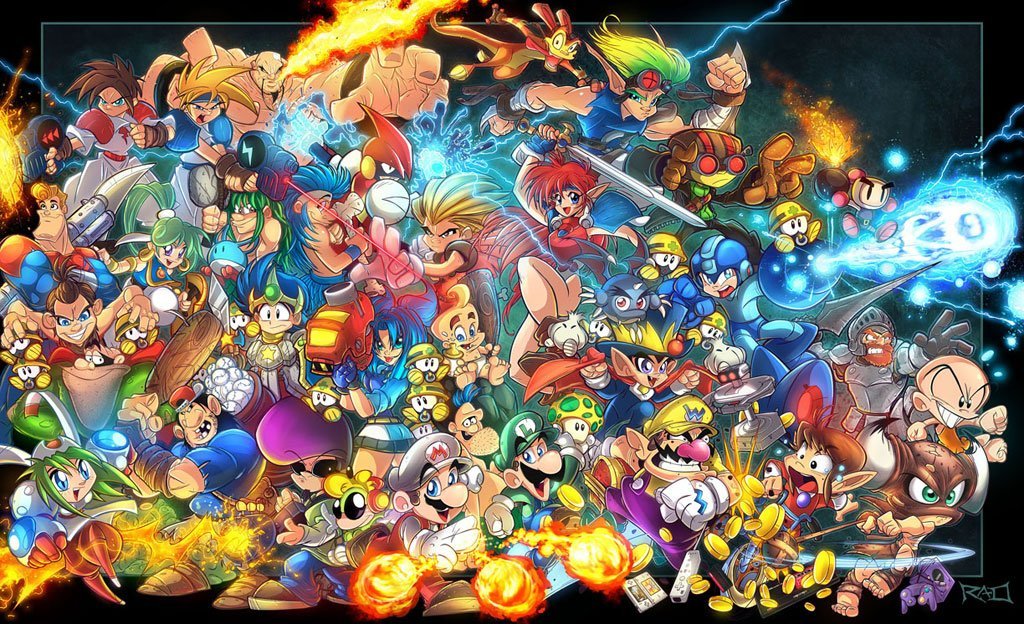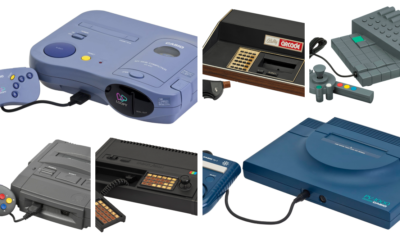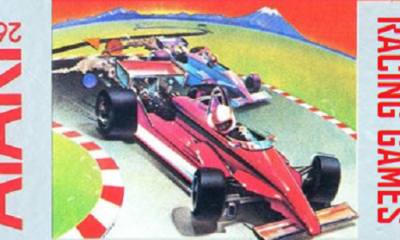Gaming
Retro Rebirth

From our tiny TV screens to the high streets, retro gaming has made a comeback and its hitting a wider audience than just gamers. We will be looking at the influence behind this fashion trend particularly in Manchester where you will find the home of retro fashion: FAB café.
Pac-Man, Bomberman, Space Invaders. These are all examples of iconic games that revolutionised the gaming industry at their peak. By now you would think it’s about time for these granddaddies of gaming to hang up their controllers and retire, making way for the next gen to have their opportunity to impact the gaming industry for years to come. Yet it seems the old fellas still have some fight left in them, maybe even more so now than ever as the retro gaming novelty has begun to take the world by storm. But not in the sense of actual gaming. Instead of continuing their full purpose, these franchises and many other retro ones like them have found a whole new industry to take on; fashion.
Now this fashion is no longer for the nerdy but for anyone; pop culture, hipster, ‘ironic’, etc. It can be argued that modern day fashionistas are attracted to the simplicity of the 8-bit art and the eye- catching colour you would see in the likes of Pac-Man.
With over thirteen years of experience in the games business, Faisal Ali, owner of Manchester’s retro games retailer Joystick Videogames has speculated the typical audience for retro.
“The main audience for the retro industry is predominantly those who have lived through such gaming eras that remind them of their childhood. The retro sector also attracts fans outside of that demographic due to its cult following, Those who can see past the dated graphics and still enjoy the underlying gameplay routines. Others like the raised challenge offered by games that would otherwise be quite short experiences if they were easy to play due to storage size restrictions. The retro audience hasn’t particularly changed as much.”
A big seller for the retro audience is original consoles, which explains why Nintendo were so successful with the re-release of the NES classic in 2016. Around 1.5 million consoles were sold worldwide last year, nearly meeting the original sales record of 2.5 million that the console saw in its first two years of release. Since then, people have been digging up these ancient fossils and selling them on at second hand retailers for a huge profit due to their high demand.
For the love of retro, even Sony are getting involved in the hype. Thousands of you entered into their competition a couple years ago in an attempt to win a 20th anniversary edition of the PS4 in all its retro glory. The next gen console sported the classic grey skin of its ancestor with a controller to match. As there was only 100 to be won, Sony compensated us all by releasing a classic PlayStation UI theme which is now one of their most successful themes of all time.
“Those who used to be big fans still hold a lot of affection for it. Collectors still prefer to own original hardware and software even if it can be emulated much easier in other ways. It’s often complained that emulation never feels “perfect” whilst playing. Our retro scene has continued solidly through our thirteen years in the business. Games have become more collectible due to raised awareness of their rarity. Some of this has been down to nonsensical newspaper articles overhyping certain format’s values and other click-bait style online articles such as: ‘Do you have a small fortune lying in your loft/garage?’.”
Although retro has made its way into fashion, we still find many uses for it in the games industry. Not just as a stimulation for our sense of nostalgia, but there are also practical uses for our ancient games.
“Retro appeals to those who have lived through such gaming eras and hanker for a reminder of the ‘good old days’. The simple, precise nature of these retro games resulted in some masterpieces that are still used as the benchmark for quality comparison to this day. It is a mix of nostalgia, less the style but more the pursuit of perfection to release something that somebody would enjoy immensely whilst still providing a good source of income for the developer, distributor and retailer.”
FAB spans across a radio station, magazine and even two bars in Manchester and Leeds, it specialises in funky themes such as retro TV, film, and games. From working directly within the retro industry, FAB owner Jordan Royce has always had a passion for all things retro:
“I have always been interested in Retro as an aesthetic, and I was into retro gaming. I saw the cabinets of the old arcade machines as a form of art. I opened FAB Café in the summer of 1998. Austin Powers had been a big hit, and there was a big demand for that type of nostalgia. It was great timing to introduce some of these themes into a venue.”
The cause of the rise in the retro appeal has been speculated widely, there was a demand for it in the nineties when technology was also on the rise.
“Towards the end of the nineties there was a great appetite for nostalgia. Retro gaming was a natural part of this imagery. In TV and cinema there was also an increasing number of reboots, and sequels that were calling back to older properties. There was also the rise of Ebay that educated people as to the value of old gaming cabinets and consoles. They were no longer junk, they had a value, and people were happy to collect them. It was a way of reliving happier times.”
Much like Faisal, Royce believes that retro has always been high demand and there has always been an audience for the industry. The only thing to have changed is what is now considered as retro.
“The appetite for retro has not diminished but has moved with the times. I believe in a type of ‘rolling retro’. Students coming into FAB when it opened in ’98 were nostalgic about shows such as Knight Rider. In recent years students, have been equally nostalgic but for properties such as Buffy the Vampire Slayer, and Power Rangers. Retro does tend to move ahead with the times.”
Buffy the Vampire Slayer was a hit TV show in the nineties with an average viewer rating of 4.5 million during it’s time. Its modern-day equivalent would be Vampire Diaries or Twilight. The young viewers who enjoyed Buffy during its hay-day are now the millennials that enjoy to relive the adventures of their childhood heroine today.
“Retro is a complete experience. A package. Someone playing a game reaches an immersion point when the simplicity of the game or experience merges with the exterior artwork, and the sounds. At that point there is a kind of comfort zone.”
Retro is now much more than a style or fashion; it is a feeling. An overwhelming sense of nostalgia can be felt merely by holding that Atari joystick in your hands or watching back your favourite Buffy episodes.

-

 Entertainment4 years ago
Entertainment4 years agoModern Technology with Not-so-Modern Origins
-

 Health And Wellness4 years ago
Health And Wellness4 years agoSigns And Symptoms Of Cancer All Men Should Be Aware Of
-

 Entertainment3 years ago
Entertainment3 years ago10 Examples of the Mandela Effect
-

 Fashion4 years ago
Fashion4 years agoHow To Cut And Style Men’s Hair At Home
-

 Gaming5 years ago
Gaming5 years ago10 Failed Consoles You’ve Probably Never Heard Of!
-

 Gaming5 years ago
Gaming5 years agoTop 10 Atari 2600 Racing Games
-

 Tech4 years ago
Tech4 years agoFuturistic Features Coming Soon To Smartphones
-

 Sports3 years ago
Sports3 years agoSimple Outdoor Tasks and How To Do Them Right